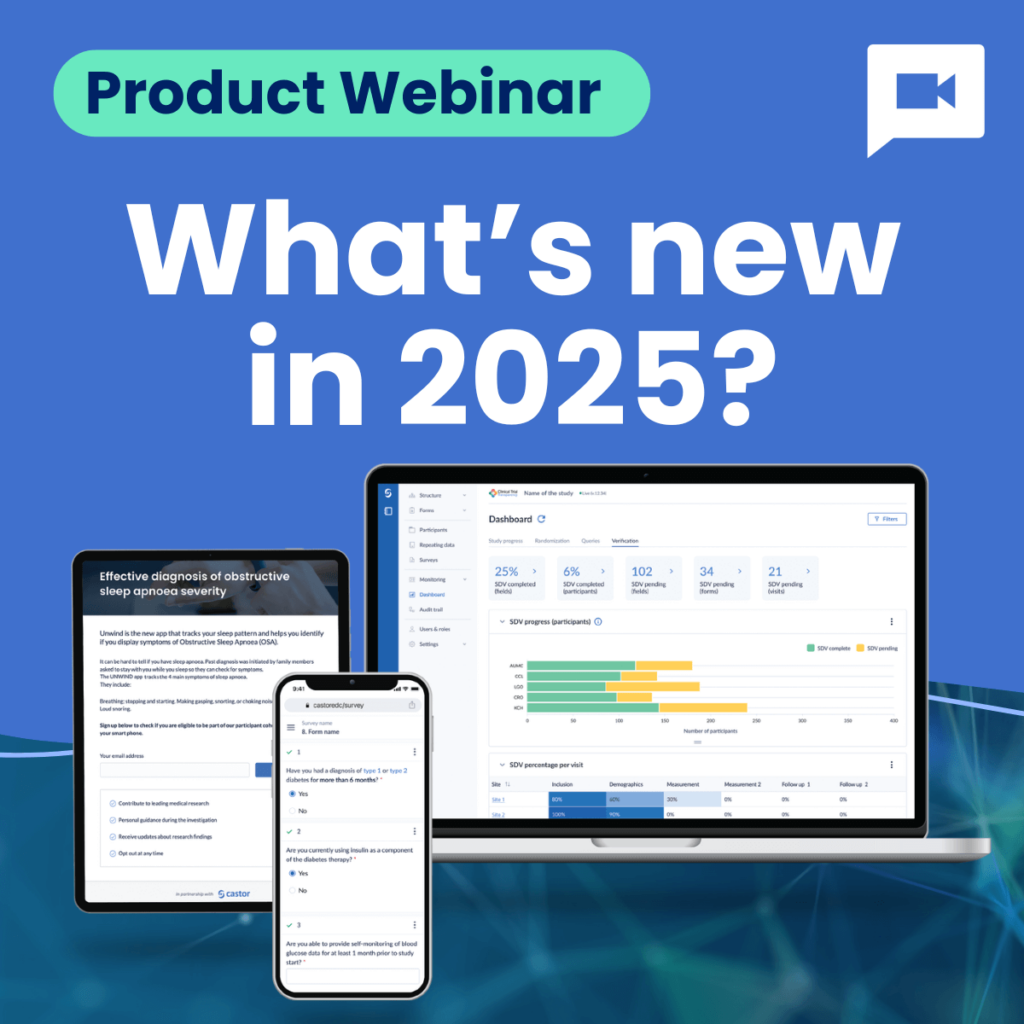eClinical systems must be flexible and adaptable to keep up with the ever-changing demands of modern clinical trials.
To accomplish this, they need to be able to integrate with other systems and exchange information. The key to this is an API.
In this article, we’ll take a closer look at the Castor API, which is built with life sciences in mind and optimized for user-friendliness and interoperability.
What is an API for clinical trials?
The Application Programming Interface (API) acts as a machine-to-machine equivalent of a user interface.
APIs in clinical research
An API lets other systems send requests to perform actions. APIs have many benefits and improve:
- Data quality by automating tasks that catch or eliminate data entry and transcription errors
- Efficiency through offering time savings by automating repetitive processes
- Extensibility by enabling developers to connect to best-in-class functionality from other systems
Everyday use cases for the Castor API are Survey Management, Progress Monitoring, and Direct Data Entry from a medical device.
Meet the Castor API – open and straightforward
We built the Castor EDC API on the REST paradigm. REST stands for REpresentational State Transfer and is one of the most widely used API paradigms in the world. The RESTful architecture describes a set of operations based on the HTTP protocol, on web resources, which are anything identifiable by a URL.
A RESTful API uses HTTP request types to interact with data:
- a GET request retrieves a resource, for example, all study data collected for a record
- a POST request creates a specific resource, for example, a new record in a study
- PUT or PATCH requests updates an existing resource, for example, unlocking an instance of a SurveyPackage
- DELETE removes the resource
The Castor API has specific URL endpoints, or resources, for different elements that Castor users usually interact with, including Study, Record, DataPoint, and SurveyPackage. See the Castor API documentation for a full list of all available endpoints and their uses.
The Castor API is an open and transparent platform with clear online documentation that has user and machine-readable formats so you can build in any language with code generation. It has easy-to-follow commands and options listed with corresponding data types and gets high marks from developers for being easy to use.
Security for a platform that manages patient data with personal health information (PHI) must be high. To achieve that, we built the Castor API on the OAuth2 specification, the industry-standard protocol for authorization. To authenticate, users create a private OAuth2 Client from their user profile. With the Client Credentials grant flow, users generate an access token for the API.
Five efficiency hacks for your clinical trials
Here are five ways that our customers use the Castor API to make their clinical trials more efficient:
- Capture device data from anywhere and stop manual imports. One medical device customer integrated their glucose monitoring device with Castor EDC to capture real-time blood sugar measurements and ePRO submissions from patient homes, and eCOA reports from study clinics. The Castor API enabled RSP Systems to centralize data across many devices automatically and remotely.
- Run complex and proprietary algorithms outside Castor, but store results with your dataset. Machine learning or artificial intelligence models run outside of Castor and are often proprietary. Using the Castor API, the algorithm can read relevant data on outcomes or predictors from Castor EDC, run the AI models, and then store the results back into the study.
- Automate data analysis and reporting with the R API wrapper. Analyzing data using R or other statistical programming languages usually requires exporting your dataset into an Excel, CSV, or SPSS format, then importing it to a tool for analysis. With Castor’s API wrapper for R API, you can script the automated retrieval of data, the analysis, or the creation of reports or graphs, directly in the statistical tool.
- Bridge the gap between different applications. You can turn a trigger from any external system into an action for Castor EDC by scripting it against the API. For example, if you register a new patient in your CTMS, you can use the Castor API to create a patient in Castor EDC automatically.
- Automate your survey management. You can use the API to add functionality that is not native to Castor. For example, Castor cannot automatically close a survey for data entry after a specific time. But if you read the status of all outstanding surveys, including their creation date, the API can close them so that they are only open for a given time.
The takeaway
The open, transparent, and easy-to-code Castor API is one of the most-used components within Castor’s integrations. We continue to invest in its development with a vast roadmap of upcoming features, many based on user requests. REST assured (pun intended) that when you develop on Castor, with the Castor API, you are building on the best-in-class system, with the best-in-class tools.
Look for our upcoming blog posts in which we will go into more depth about some of the compelling use cases we are seeing.
Interested in learning more about the Castor API? Schedule a demo today.


